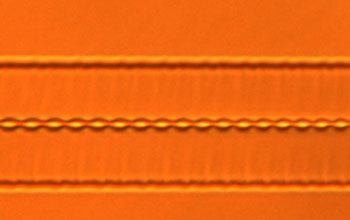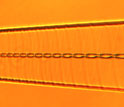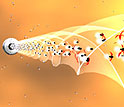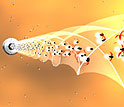News Release 04-088
A New Twist on Fiber Optics
Spiraling glass fibers provide new way to control behavior of light

Chiral optical fiber created by Chiral Photonics. Fiber is less than 100 millionths of a meter ...
July 1, 2004
This material is available primarily for archival purposes. Telephone numbers or other contact information may be out of date; please see current contact information at media contacts.
ARLINGTON, Va.—By twisting fiber optic strands into helical shapes, researchers have created unique structures that can precisely filter, polarize or scatter light. Compatible with standard fiber optic lines, these hair-like structures may replace bulky components in sensors, gyroscopes and other devices.
While researchers are still probing the unusual properties of the new fibers, tests show the strands impart a chiral, or "handed," character to light by polarizing photons according to certain physical properties.
Victor Kopp of Chiral Photonics in Clifton, N.J., and his colleagues describe the new fibers in the July 2 issue of Science.
Several of these fibers, and their applications, are being developed in part with funds from the National Science Foundation Small Business Innovation Research program.
In conventional optical fibers, light is transmitted from one end to the other through a round core housed within a concentric outer cladding. But, because a circular core does not develop handedness when twisted, the research team wound rectangular-core fibers to create a double helix.
When the team tested the twisted fiber, they discovered that some photons left the core and entered the cladding. Photons with the same handedness as the fiber entered the cladding whereas photons with handedness opposite that of the fiber remained in the core.
With only a relatively loose twist-roughly 100 microns to form a complete turn-photons with a handedness that coincides with the fiber's twist scatter out of the core at a shallow angle and are trapped in the cladding. With a tighter twist, photons with the same handedness as the fiber scatter at a wider angle, allowing the photons to escape from the cladding into the surrounding space. Only light of a single polarization remains in the fiber (see animation). At the tightest twists, roughly one-millionth of a meter to complete a turn, photons with the same handedness as the structure are reflected backwards in the core.
Because the environment surrounding the fiber affects the wavelength of the light embedded in the cladding, "loosely" twisted fibers can serve as sensors for pressure, temperature, torque and chemical composition.
With moderately twisted fibers, researchers can manipulate the resulting polarized light in useful ways, leading to a range of applications such as gyroscopes for navigation systems, current meters for electric power stations, and chemical and materials analysis equipment.
For tightly wound fibers, the amount of twist determines the precise wavelength of the light remaining in the fiber, producing light that is ideal for filter and laser applications.
Chiral Photonics is developing manufacturing processes for commercial production of the technology. Using a small filament oven, technicians soften the optical fibers while twisting them, which allows greater control of the process.
This research was funded both NSF and the National Institute of Standards and Technology Advanced Technology Program.
Comments from NSF:
"This technology could be one of the most significant recent advances in the field of polarization and wavelength control. Equally impressive is the innovative science that will be developed based on this new technology. This project should advance the current understanding in advanced fiber structures." — Winslow Sargeant, the NSF program officer who oversees the Chiral Photonics SBIR award.
"There is an enormous host of applications for which chiral fiber gratings could find markets. Fiber Bragg gratings (FBGs) are a well-established technology for transmitting data, but suffer from high cost due to the equipment and time required to craft them. Chiral fiber gratings can replace FBGs in some applications with the possible added advantage of low-cost production." — Winslow Sargeant
Comments from the researchers:
"We believe the creative process is only beginning as these photonic building blocks that add functionality into fiber are being introduced to the ingenuity of photonic designers and their applications." — Dan Neugroschl, President, Chiral Photonics.
"We have shown that chiral fibers with a wide range of twists can be created in a versatile continuous manufacturing process under computer control. These fibers are the physical structure in which different states of a light wave can be coupled to perform useful functions." — Azriel Genack, CTO, Chiral Photonics.
"These fibers are unique because light moving along the fiber core with a specific wavelength and polarization can either be coupled to a more slowly moving wave in the cladding surrounding the fiber core, or be scattered out of the fiber or be sent backwards within the core." — Victor Kopp, Director of R&D
-NSF-
-
Tapered chiral optical fiber created by Chiral Photonics. Fiber is less than 100 millionths of ...
Credit and Larger Version -
View Video
This NSF animation demonstrates how a beam of unpolarized light can be filtered into a polarized ...
Credit and Larger Version -
View Video
Download video (filesize: 37MB)
Credit and Larger Version
Chiral Photonics, Inc.
www.ChiralPhotonics.com
Media Contacts
Josh Chamot, NSF, (703) 292-7730, email: jchamot@nsf.gov
Michael Baum, NIST Public Affairs Officer, (301) 975-2763, email: michael.baum@nist.gov
Program Contacts
Winslow Sargeant, NSF SBIR Officer, (703) 292-7313, email: wsargean@nsf.gov
Principal Investigators
Dan Neugroschl, Chiral Photonics, Inc., (973) 594-8888, email: DanN@ChiralPhotonics.com
The U.S. National Science Foundation propels the nation forward by advancing fundamental research in all fields of science and engineering. NSF supports research and people by providing facilities, instruments and funding to support their ingenuity and sustain the U.S. as a global leader in research and innovation. With a fiscal year 2023 budget of $9.5 billion, NSF funds reach all 50 states through grants to nearly 2,000 colleges, universities and institutions. Each year, NSF receives more than 40,000 competitive proposals and makes about 11,000 new awards. Those awards include support for cooperative research with industry, Arctic and Antarctic research and operations, and U.S. participation in international scientific efforts.
Connect with us online
NSF website: nsf.gov
NSF News: nsf.gov/news
For News Media: nsf.gov/news/newsroom
Statistics: nsf.gov/statistics/
Awards database: nsf.gov/awardsearch/
Follow us on social
Twitter: twitter.com/NSF
Facebook: facebook.com/US.NSF
Instagram: instagram.com/nsfgov





